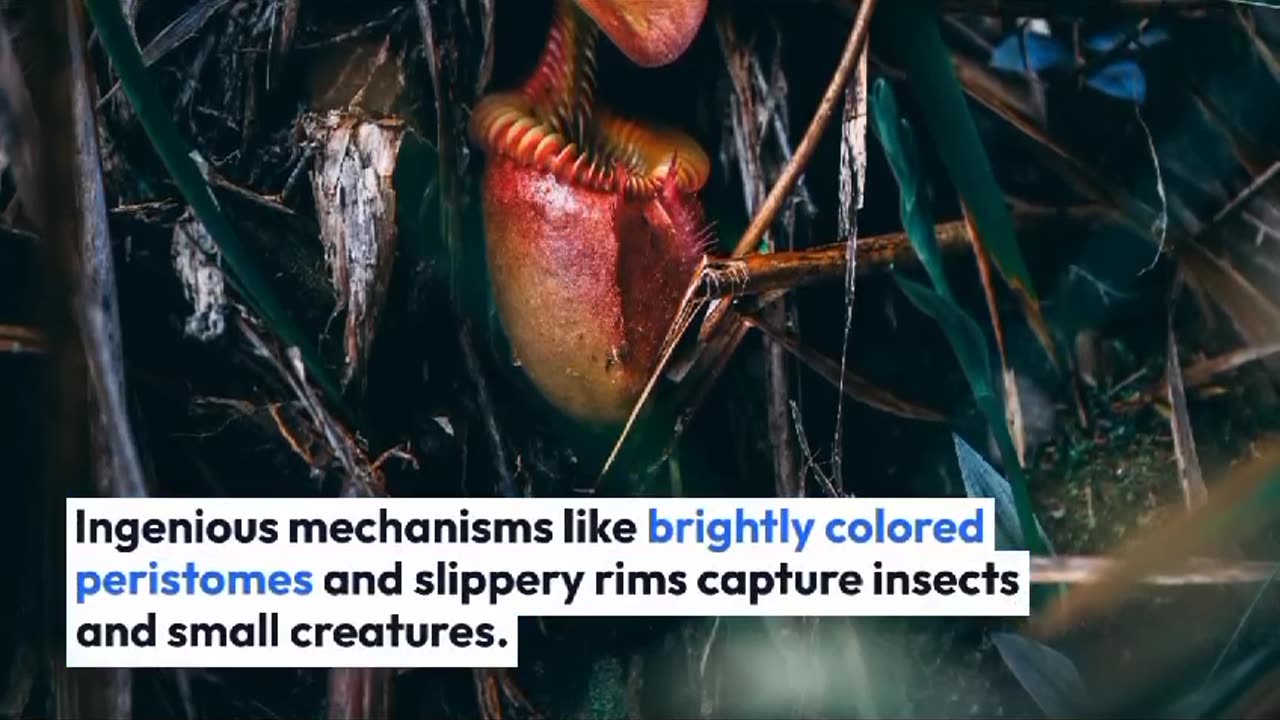Premium Only Content

Pitcher Plants: Carnivorous Bog Plants and Their Fascinating Traps
Welcome to our video on pitcher plants, fascinating carnivorous bog plants that have evolved unique trapping mechanisms. In this video, we will explore the world of pitcher plants, their various species, and the captivating ways in which they catch and digest their prey. Join us as we delve into the intriguing world of these remarkable plants.
Pitcher plants are a group of carnivorous plants that thrive in boggy or swampy areas. They have adapted to their nutrient-poor environments by developing specialized leaves that form pitcher-shaped traps. These traps serve as enticing lures for unsuspecting insects and other small creatures.
Pitcher plants belong to several different genera, including Sarracenia, Nepenthes, and Cephalotus. Each genus has its own unique characteristics and trapping mechanisms.
The pitcher-shaped leaves of these plants are modified and specialized to create their enticing traps. The traps consist of several parts, including the lid, peristome (the slippery rim), and the digestive fluid within the pitcher. The lid prevents rainwater from diluting the digestive fluid and acts as a shield to keep larger prey from escaping.
To capture their prey, pitcher plants have evolved ingenious mechanisms. The brightly colored peristome, covered in nectar-producing glands, attracts insects to the opening of the pitcher. The slippery rim causes insects to lose their footing and fall into the pitcher. Once inside, it becomes difficult for them to escape due to the downward-pointing hairs or waxy surfaces lining the interior walls.
Once the prey is trapped inside the pitcher, the digestive process begins. The fluid within the pitcher contains enzymes that break down the captured insects, converting them into nutrients that the plant can absorb. The enzymes dissolve the soft tissues of the prey, allowing the plant to extract vital nutrients such as nitrogen and phosphorus, which are scarce in their boggy habitats. Some pitcher plants also have specialized bacteria in their pitchers that aid in the digestion process.
Pitcher plants have evolved unique adaptations to survive in nutrient-poor environments. Their ability to capture and digest insects provides them with an additional source of nutrients, supplementing what they can obtain from the surrounding soil.
There are many species of pitcher plants, each with its own unique characteristics and growing requirements. Sarracenia purpurea, Nepenthes ventricosa, and Cephalotus follicularis are just a few examples. These plants have specific needs for light, humidity, and temperature, so it's important to research and understand their requirements before growing them.
Conserving pitcher plants is crucial, as they face various threats in their natural habitats. Habitat destruction, climate change, and illegal collection pose significant risks to these remarkable plants. Supporting local conservation organizations, promoting sustainable gardening practices, and avoiding the illegal collection of wild pitcher plants are ways to contribute to their conservation.
Pitcher plants truly are wonders of nature. From their captivating traps to their remarkable adaptations, they continue to intrigue and inspire plant enthusiasts worldwide. Let's appreciate and protect these fascinating plants for future generations to enjoy.
Thank you for joining us on this exploration of pitcher plants. If you found this video informative and inspiring, be sure to subscribe to our channel for more fascinating content on plants and gardening.
-
 13:22
13:22
Stephen Gardner
3 hours ago🔥You'll NEVER Believe what Trump wants NOW!!
37.5K82 -
 54:56
54:56
Digital Social Hour
1 day ago $3.65 earnedDOGE, Deep State, Drones & Charlie Kirk | Donald Trump Jr.
15.7K -
 DVR
DVR
The Trish Regan Show
4 hours agoTrump‘s FCC Targets Disney CEO Bob Iger Over ABC News Alleged Misconduct
25.4K19 -
 1:48:19
1:48:19
The Quartering
5 hours agoElon Calls White People Dumb, Vivek Calls American's Lazy & Why Modern Christmas Movies Suck!
94.9K54 -
 2:08:42
2:08:42
The Dilley Show
6 hours ago $28.05 earnedH1B Visa Debate, Culture and More! w/Author Brenden Dilley 12/26/2024
80.2K22 -
 4:55:59
4:55:59
LumpyPotatoX2
8 hours agoThirsty Thursday on BOX Day - #RumbleGaming
84.3K5 -
 1:04:52
1:04:52
Geeks + Gamers
7 hours agoDisney RATIO'D on Christmas Day | Mufasa Embarrassed By Sonic 3
62.8K4 -
 8:27:46
8:27:46
Sm0k3m
11 hours agoPlaying games on Rumble
38.2K2 -
 10:37
10:37
Russell Brand
2 days agoHow is this even allowed?
186K854 -
 1:37:26
1:37:26
Real Coffee With Scott Adams
8 hours agoEpisode 2701 CWSA 12/26/24
102K91